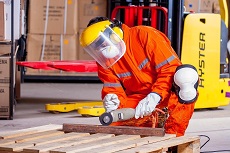
In today’s world, we are witnessing overgrowing industries, creating thousands of opportunities for the labor force. Some people try their luck in organizations, taking up mentally challenging jobs, while others opt for physically demanding jobs in the manufacturing sector. Industrialists are making every possible effort to promote employee wellness while ensuring social responsibility towards the environment.
Unfortunately, safety measures are neglected at times since it takes additional time and effort, but do you think it is worth risking worker’s life? Believe it or not, but workplace injuries and accidents are universal as every seven seconds, a worker suffers an injury. Thus, focus on building a safe and healthy workplace, where employees enjoy working to boost productivity levels.
Safety culture has to be in the DNA of every manufacturing business, but remember, safety in the workplace is a lot more than wearing yellow caps and following routine protocols. You have to ensure compliance with workplace health and safety measures while schooling workers about all the safety concerns. If you are clueless about it, here are ten daily workplace safety tips in manufacturing.
- Report Unsafe Conditions Beforehand
Regular inspections of the manufacturing sites will help you identify things and places that can hurt people. You might come across a cracking ceiling, broken staircase, or electrical wires spread on the ground. Instead of waiting for the supervisor to notice these things, you have to report such conditions beforehand or take immediate action yourself. Likewise, limit access to areas that are relatively dangerous – for instance, the electric powerhouse.
- Install Fire Suppression Systems
Usually, manufacturing businesses are using combustible materials, making them vulnerable to the risk of fire outbreaks. It is impossible to avoid the usage of flammable material, but ensuring relevant safety measures is in your hands. Thus, consider installing fire suppression systems to confirm the immediate call to action in case of emergencies. These systems release extinguishing agent within 10 seconds, while not leaving any cleaning residue behind. It not only gives your business a backup but also reduces recovery time from a fire event.
- Ensure Use of Safety Gear
In manufacturing businesses, employees have to work with heavy equipment, and for this, bright or colorful gear is not sufficient. You have to invest in proper safety gear for all the workers – protective boots, vests, and eyewear to protect eyes from resilient electric waves. Sometimes, the sound of the equipment is loud. Thus, you have to equip workers with earplugs to save their eardrums. Besides, workers have to ensure their personal protective equipment (PPE) is in excellent condition without damages.
- Clear Out Emergency Exits
At times, businesses have huge stacks of cartons and boxes piled up in front of the emergency exit door. Perhaps, one thinks these exits are of no use, so utilize them as storage spaces. This could serve as a massive threat to your workers and business. Therefore, ensure the area is clear from any mess to allow a smooth exit in case of an emergency. Similarly, check the doorknobs and handles to ensure the rust has not jammed them up.
- Use Tools Properly
Sometimes, workers fail to take things seriously. You might witness them playing with the equipment while throwing tools at each other. Unfortunately, the most common source of injuries is the misuse of tools and machines. Thus, you have to train all the workers to ensure equipment and devices are being used in an intended way, closing doors for injuries and mistakes.
- Prioritize Hygiene
Who likes clutter lying on every corner? Alongside making the place look like a mess, scattered objects on the floor increase the chances of slipping and tripping. Similarly, heaps of clutter can also shoot up stress levels of workers, increasing clumsiness while reducing cognitive abilities. Therefore, keep the aisles clean, neat, and tidy; you can either ask workers to clean their station or hire someone for this job.
- Maintain the Correct Posture
Workers have to take up a lot of physical work demanding strength and power. Likewise, they have to lift heavy boxes to transport them from one place to another. Indeed, back strains are a frequent issue, but before it turns into a significant back problem, help them learn the correct posture. For instance, when lifting boxes, ask them to sit and pick the box rather than bending.
- Label Danger Zones
Usually, manufacturing businesses have different departments. Some workers are sweating with heavy machinery, dealing with chemicals, while others are working with electric wires. If the area is dangerous, you do not have to open access for everyone. Have you seen those yellow caution boards? You can place them in walkways and corridors to restrict access.
- Immediately Dispose of Hazardous Materials
Almost every manufacturing business deals with hazardous material. It raises concerns when these materials are tracked into other areas. You have to ensure these dangerous elements stay in their required departments. Also, prevent-cross contamination by using effective cleaning solutions, keeping doormats clean, and disposing of them properly. Workers immediately have to change clothes when heading out, knocking off safety concerns.
- Stay Careful!
Workers have to take safety in their hands. You might be making every possible effort to provide a safe workplace, but nothing will work if workers are not serious. Therefore, discuss potential safety concerns, and workers have to stay careful. If they notice objects are on the verge of falling, they should know how to use protective nets to prevent any damage.
Summary
Owners have to adopt a holistic approach when running a manufacturing business. Alongside evaluating quality standards, you have to keep up with safety measures. You have to ensure no compromise on safety measures to increase capacity or maximize productivity. If you wish to learn more, have a look above.






